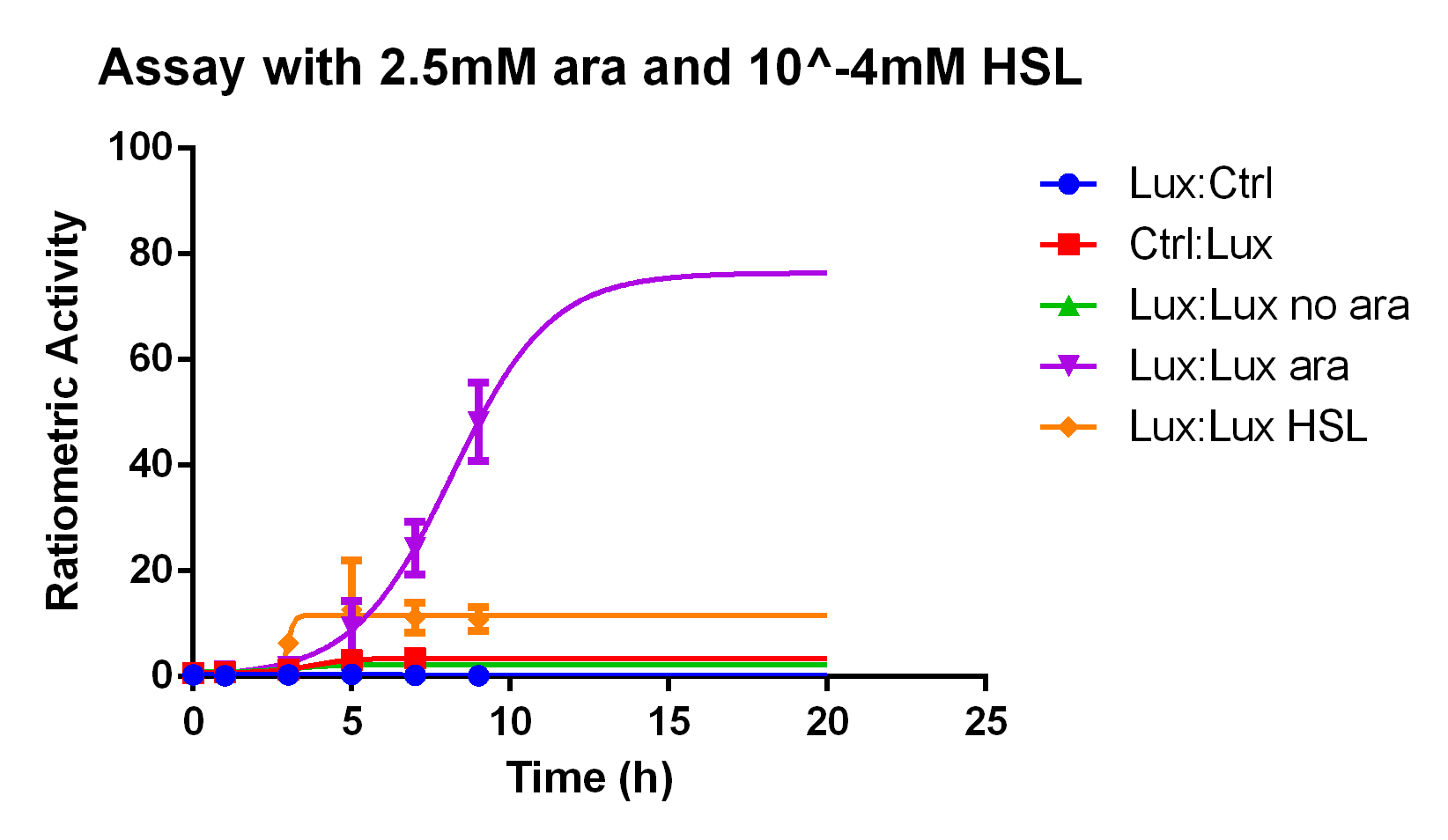Difference between revisions of "Part:BBa I13015"
Felipebuson (Talk | contribs) |
Felipebuson (Talk | contribs) |
||
| Line 22: | Line 22: | ||
Team USP-Brazil (2018) characterized this part by using it in a quorum sensing system along with LuxR and promoter pLux (see [https://parts.igem.org/Part:BBa_K2771030 BBa_K2771030]), in an assay comparing pBad at full activity (2.5mM arabinose) and a quantity known to activate well pLux (10<sup>-4</sup> mM HSL). Arabinose induction showed an equilibrium about 7x higher than with just synthetic HSL, and a bigger EC50, due to the necessity of transcription of two genes and signal production by LuxI for the reporter to be seeable: | Team USP-Brazil (2018) characterized this part by using it in a quorum sensing system along with LuxR and promoter pLux (see [https://parts.igem.org/Part:BBa_K2771030 BBa_K2771030]), in an assay comparing pBad at full activity (2.5mM arabinose) and a quantity known to activate well pLux (10<sup>-4</sup> mM HSL). Arabinose induction showed an equilibrium about 7x higher than with just synthetic HSL, and a bigger EC50, due to the necessity of transcription of two genes and signal production by LuxI for the reporter to be seeable: | ||
| − | [[File:T--USP-Brazil--ara HSL assay.png|500px|thumb|none|alt=experiment 1.|Figure 2: Liquid culture assay with 2.5 mM arabinose or 10<sup>-4</sup> mM 3OC6 HSL induction at 0h. Arabinose induction shows clearly higher concentration of HSL than in the synthetic HSL curve, showing higher curve inclination and higher equilibrium point]] | + | [[File:T--USP-Brazil--ara HSL assay.png|500px|thumb|none|alt=experiment 1.|Figure 2: Liquid culture assay with 2.5 mM arabinose or 10<sup>-4</sup> mM 3OC6 HSL induction at 0h. Arabinose induction shows clearly higher concentration of HSL than in the synthetic HSL curve, showing higher curve inclination and higher equilibrium point. Fluorescence measured as a ratio of a YFP reporter with the quorum sensing promoter, normalized by the value of a constitutive CFP reporter, proxy for cell conditions and environmental influence]] |
Latest revision as of 17:43, 17 October 2018
3OC6HSL Sender controlled by pBad
The pBad promoter controlling a LuxI sender device. The protein is an untagged LuxI enzyme which produces an AHL (3OC6HSL).
Sequence and Features
Assembly Compatibility:
- 10COMPATIBLE WITH RFC[10]
- 12INCOMPATIBLE WITH RFC[12]Illegal NheI site found at 1205
- 21INCOMPATIBLE WITH RFC[21]Illegal BglII site found at 1873
Illegal BamHI site found at 1144 - 23COMPATIBLE WITH RFC[23]
- 25INCOMPATIBLE WITH RFC[25]Illegal AgeI site found at 979
- 1000INCOMPATIBLE WITH RFC[1000]Illegal SapI site found at 961
Activity compared to synthetic 3OC6 HSL
Team USP-Brazil (2018) characterized this part by using it in a quorum sensing system along with LuxR and promoter pLux (see BBa_K2771030), in an assay comparing pBad at full activity (2.5mM arabinose) and a quantity known to activate well pLux (10-4 mM HSL). Arabinose induction showed an equilibrium about 7x higher than with just synthetic HSL, and a bigger EC50, due to the necessity of transcription of two genes and signal production by LuxI for the reporter to be seeable:

Figure 2: Liquid culture assay with 2.5 mM arabinose or 10-4 mM 3OC6 HSL induction at 0h. Arabinose induction shows clearly higher concentration of HSL than in the synthetic HSL curve, showing higher curve inclination and higher equilibrium point. Fluorescence measured as a ratio of a YFP reporter with the quorum sensing promoter, normalized by the value of a constitutive CFP reporter, proxy for cell conditions and environmental influence
